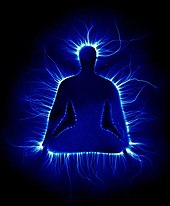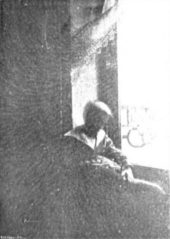Aura (paranormal)

| New Age beliefs List of New Age topics |
|---|
 |
| Concepts |
| Spiritual practices |
| Doctrines |
| Part of a series on the |
| Paranormal |
|---|
According to spiritual beliefs, an aura or
In
Etymology
In Latin and Ancient Greek, aura means wind, breeze or breath. It was used in Middle English to mean "gentle breeze". By the end of the 19th century, the word was used in some spiritualist circles to describe a speculated subtle emanation around the body.[6][7]
History

The concept of auras was first popularized by
In the following years, Leadbeater's ideas on the aura and chakras were adopted and reinterpreted by other theosophists such as Rudolf Steiner[15] and Edgar Cayce, but his occult anatomy remained of minor interest within the esoteric counterculture until the 1980s, when it was picked up by the New Age movement.[16]
In 1977, American esotericist
Auric energy
In yoga participants attempt to focus on, or enhance their "auric energy shield".[23] The concept of auric energy is spiritual and is concerned with metaphysics. Some people think that the aura carries a person's soul after death.[24]
Aura photography

There have been numerous attempts to capture an energy field around the human body, going as far back as photographs by French physician Hippolyte Baraduc in the 1890s.[25] Supernatural interpretations of these images have often been the result of a lack of understanding of the simple natural phenomena behind them, such as heat emanating from a human body producing aura-like images under infrared photography.[26]

In 1939,
More recent attempts at capturing auras include the Aura Imaging cameras and software introduced by Guy Coggins in 1992. Coggins claims that his software uses biofeedback data to color the picture of the subject. The technique has failed to yield reproducible results.[26]
Tests

Tests of psychic abilities to observe alleged aura emanations have repeatedly been met with failure.[26]
One test involved placing people in a dark room and asking the psychic to state how many auras she could observe. Only chance results were obtained.[31]
Recognition of auras has occasionally been tested on television. One test involved an aura reader standing on one side of a room with an opaque partition separating her from a number of slots which might contain either actual people or mannequins. The aura reader failed to identify the slots containing people, incorrectly stating that all contained people.[32]
In another televised test another aura reader was placed before a partition where five people were standing. He claimed that he could see their auras from behind the partition. As each person moved out, the reader was asked to identify where that person was standing behind the slot. He identified two out of five correctly.[33]
Attempts to prove the existence of auras scientifically have repeatedly met with failure; for example people are unable to see auras in complete darkness, and auras have never been successfully used to identify people when their identifying features are otherwise obscured in controlled tests.[26][31][32][33] A 1999 study concluded that conventional sensory cues such as radiated body heat might be mistaken for evidence of a metaphysical phenomenon.[34]
Scientific explanation
Psychologist
It has been suggested that auras may result from
Other causes may include disorders within the visual system provoking optical effects.[citation needed]
Bridgette Perez, in a review for the Skeptical Inquirer, wrote: "perceptual distortions, illusions, and hallucinations might promote belief in auras... Psychological factors, including absorption, fantasy proneness, vividness of visual imagery, and after-images, might also be responsible for the phenomena of the aura."[43]
Scientists have repeatedly concluded that the ability to see auras does not actually exist.[26][31][32][33]
In popular culture
- The book
See also
- Aureola
- Clairvoyance
- Confirmation bias
- Energy field disturbance
- Halo (religious iconography)
- Human Design
- Lesya
- List of topics characterized as pseudoscience
- Metaphysics
- Scientific skepticism
- Spirit photography
References
- ^ a b Hanegraaff 2006, p. 857.
- ^ Hammer 2001, p. 55.
- ^ Hines 2002, p. 427.
- ^ Hines 2002, pp. 362–70.
- ISBN 1573928046.
- ^ "Online Etymology Dictionary". Etymonline.com. Retrieved 2017-05-21.
- ^ Marques, A. (1896). The Human Aura: A Study. Office of Mercury. pp. 1–2 and preface. Retrieved 17 May 2017.
- ^ Hanegraaff 2006, p. 686.
- ^ Tillett 1986, p. 193.
- ^ Tillett 1986, pp. 220–22.
- ^ Tillett 1986, p. 235.
- ISBN 9781471747038. Retrieved 14 May 2017.
- ^ Hammer 2001, p. 183.
- ^ Hammer 2001, pp. 184–87.
- ISBN 0880103736. Archived from the original(PDF) on 27 February 2019. Retrieved 17 May 2017.
- ^ Hammer 2001, p. 187.
- ISBN 9780916438098. Retrieved 17 May 2017.
- ^ Hammer 2001, p. 188.
- ^ Hammer 2001, p. 92.
- ISBN 9780609800140. Retrieved 17 May 2017.
- ^ Hammer 2001, p. 189.
- ISBN 0553345397. Retrieved 22 June 2014.
- ISBN 978-1797211282. Retrieved 15 April 2022.
- ISBN 978-1594773396. Retrieved 15 April 2022.
- ^ Baraduc, Hippolyte (1896). L'ame humaine: ses mouvements, ses lumières et l'iconographie de l'invisible fluidique (in French). G. Carré. p. 61. Retrieved 19 May 2017.
- ^ a b c d e Joe Nickell (May 2000). "Aura Photography: A Candid Shot". The Committee for Skeptical Inquiry. Retrieved 2016-10-21.
- ^ Hammer 2001, pp. 240–43.
- PMID 968480.
- ISBN 0879756551.
- ^ Hines 2002, pp. 427–28.
- ^ a b c Loftin, Robert W. (1990). "Auras: Searching for the Light". The Skeptical Inquirer. 24. Committee for the Scientific Investigation of Claims of the Paranormal: 403–09.
- ^ a b c "Auras". The Skeptic's Dictionary. Archived from the original on 5 December 2006. Retrieved 2006-12-15.
- ^ a b c "James Randi tests an aura reader". YouTube. 28 December 2007. Archived from the original on 2021-12-21. Retrieved 2008-01-14.
- ^ "Perception of Conventional Sensory Cues as an Alternative to the Postulated'Human Energy Field'of Therapeutic Touch (PDF Download Available)". The Scientific Review of Alternative Medicine (Fall/Winter). 1999.
- ISBN 0486261670.
- ^ Fraser-Harris, D. F. (1932). A psycho physiological explanation of the so-called human "aura". British Journal of Medical Psychology 12: 174–84.
- ^ Dale, A., Anderson, D. & Wyman, L. (1978). Perceptual Aura: Not Spirit but Afterimage and Border Contrast Effects. Perceptual and Motor Skills 47: 653–54.
- S2CID 23939287.
- ^ "Familial occipitotemporal lobe epilepsy and migraine with visual aura". Neurology.org. Archived from the original on 2007-09-27. Retrieved 2017-05-21.
- ^ "auras – The Skeptic's Dictionary". Skepdic.com. Retrieved 2015-03-05.
Thus, perhaps some cases of seeing auras can be explained by synesthesia rather than assuming that auras are energies given off by chakras or signs of delusion or fraud.
- S2CID 8364181.
- ^ Novella, Steven (2012-05-07). "Is Aura Reading Synaesthesia? Probably Not". Skepticblog. Retrieved 2016-10-21.
- ^ Bridgette M. Perez (January 2011). "The Aura: A Brief Review". The Committee for Skeptical Inquiry. Retrieved 2015-03-05.
- ISBN 9780345340382.
- ISBN 9780860517818.
- ISBN 9780861711918.
Works cited
- Hanegraaff, Wouter J. (2006). Dictionary of Gnosis & Western Esotericism. Leiden: Brill. ISBN 9789004152311.
- Hammer, Olav (2001). Claiming Knowledge: Strategies of Epistemology from Theosophy to the New Age. Leiden: Brill. ISBN 900413638X.
- Hines, Terence (2002). Pseudoscience and the Paranormal (2nd ed.). Amherst, New York: Prometheus Books. ISBN 1573929794.
- Tillett, Gregory John (1 January 1986). Charles Webster Leadbeater 1854–1934: a biographical study (Thesis). University of Sydney. hdl:2123/1623.
